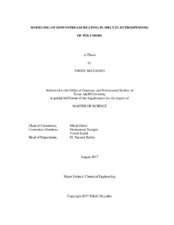| dc.description.abstract | The current study is driven by the demand for sub-micron fibers with high surface area to volume ratios to be used in applications such as high performance filtration, tissue engineering, in-situ wound dressing, drug delivery, thermal management, and energy storage.
Traditionally, industry has been using solution electrospinning for manufacturing sub-micron fibers. However, it is expensive and environmentally unfavorable because a significant quantity of toxic solvent is lost to the surroundings during this process. The alternative approach, melt electrospinning, is inherently limited to the production of micron-sized fibers. This is mainly due to the high viscosity and low electrical conductivity of the melt. In addition, rapid heat loss to the surroundings results in solidification of the polymer melt jet before it has been significantly stretched by the electric field.
In order to address this problem, we propose that a volumetric heat source placed downstream in the melt electrospinning process can lead to markedly decreased fiber diameters. For this purpose, we utilize a model for non-isothermal melt electrospinning in the presence of a downstream volumetric heat source. The model is based on thin filament approximation applied to fully coupled momentum, continuity, charge, and energy equations, along with the non-isothermal Giesekus constitutive model and the electric field equation at steady state.
The simulation results demonstrate that downstream heating does reduce the fiber diameter, and is therefore a feasible solution for resolving the drawbacks of melt electrospinning. In addition, the model has been used to capture the influence of the surrounding temperature, which affects the thinning of the fiber through surface rather than volumetric interactions. Finally, experiments on melt electrospun polycaprolactone are utilized in order to validate the model predictions. | en |


